page 9
(Using a philosophy of "threes" as a tool for comparative analysis)
http://threesology.org
Anat., Bio. Phys. Researchers as of 3/17/2021
Pages in this series:
| 1 | 2 | 3 | 4 | 5 | 6 | 7 | 8 | 9 | 10 | 11 |
Since the topic of biology concerns a discussion of time-related ideas such as circadian (or other environmentally dependent biological) rhythms, maturational progression, etc., let's place the concept of time (as an arrow) into a dynamic framework associated to the double helix and try to visualize a whirling motion even though most images of the double helix are seen as a non-moving (static) model. One can further ascribe to the notion that the DNA strand within an active biological domain is either moving (revolving?) or not... unless one prefers to visualize an end-over-end or some alternative movement:
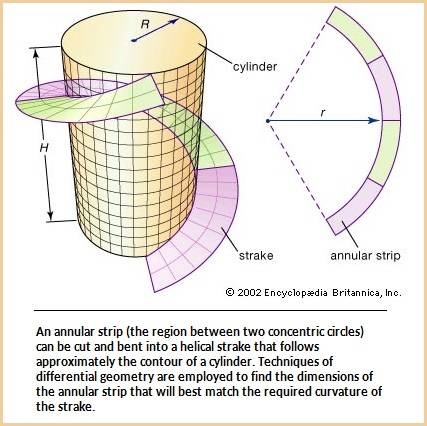 |
 |
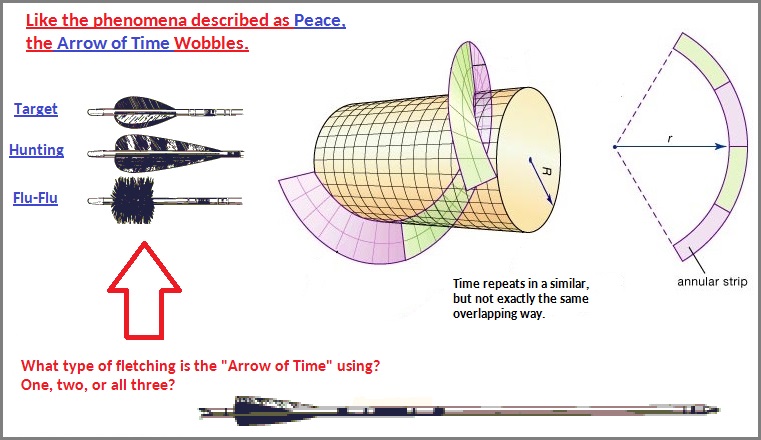 |
|
Let's talk peace page 13
Whereas it is well-recorded that both lunar and solar eclipses (not to mention extreme events in nature such as floods or seasons [or the lack/ absence thereof] have caused alterations in human behavior due to being perceived as a good, bad or negligible "sign", the effects of unrecorded trends on unrecognized anatomical, biological, or physiological changes for (or because of) adaptations is a biometric that is not a typical subject of discussion in identifying basic "impressions" left on humanity like the image left over after an animal has been branded. If a brand is widespread and one is born with it, the brand may be taken for granted as to be unidentified... and even forgotten has having ever been in existence if it deteriorates over expanses of time that memory or other records are lost. In a sense, humanity exhibits many types of "prints" or impressions, most of which are overlooked, just as fingerprints, ear shape and other obvious particulars once were.
Types of (fingerprint) patterns (As they are identified today.):
Fingerprints may be resolved into three large general groups of patterns, each group bearing the same general characteristics or family resemblance. The patterns may be further divided into sub-groups by means of the smaller differences existing between the patterns in the same general group. These divisions are as follows:
- ARCH- Plain arch, and Tented arch.
- LOOP- Radial loop, Ulnar loop, Central pocket loop, and Double loop.
- WHORL- Plain whorl and Accidental whorl.
types of pattern and their interpretation
(And let us wonder if the fingerprints of early hominids or primates exhibited the same three-patterned types.)
Fingerprints are classified in a three-way process:
The information obtained in this way is incorporated in a concise formula, which is known as the individual's fingerprint classification. There are several variants of the Henry* system, but that used by the Federal Bureau of Investigation (FBI) in the United States recognizes eight different types of patterns: radial loop, ulnar loop, double loop, central pocket loop, plain arch, tented arch, plain whorl, and accidental. Whorls are usually circular or spiral in shape. Arches have a mound-like contour, while tented arches have a spikelike or steeple-like appearance in the centre. Loops have concentric hairpin or staple-shaped ridges and are described as "radial" or "ulnar" to denote their slopes; ulnar loops slope toward the little finger side of the hand, radial loops toward the thumb. Loops constitute about 65 percent of the total fingerprint patterns; whorls make up about 30 percent, and arches and tented arches together account for the other 5 percent. The most common pattern is the ulnar loop. *(It was the) English scientist Sir Francis Galton, who suggested the first elementary system for classifying fingerprints based on grouping the patterns into arches, loops, and whorls. Source: "Fingerprint." Encyclopædia Britannica Ultimate Reference Suite, 2013. |
Interestingly, the "loop" gives the impression of a warped line, as if the arrow of time were being subjected to a field of distortion. In furthering this analogy, we could say that fingerprints exhibit a micro-cosmic model of macro-scopic events occurring in the universe. For example, if we take the visualized "linear" arrow of time and subject it to a strong magnetic field or suggest it has an internalized flexibility which allows it to be "warped" according to whatever is providing a constant bombardment or lack thereof (such as a pressure-gradient difference/differential) seen in the mathematics of air flow over and above a wing; we thus have a situation in which we see yet another reference to the linear-circular-triangular configuration mentioned previously. No less, if fingerprints can be viewed as a representative portrait of magnetic lines such as those seen when the geo-magnetism of the Earth is subjected to the bombardment of solar rays, we might thus ascertain that biology keeps a record of external body events like the rings of trees do to environmental conditions. We need only develop the conscious methodology of designing an appropriate philosophy of decipherment and application.
While our view of fingerprints is a static one, this does not mean that which made the imprint was also static. The biological makeup of humans may be like a primitive form of camera which takes/makes "still" pictures and not motion pictures, though fingerprints may in fact portray a dynamic (moving) process, similar to that which helped to originate the idea of a mechanical universe to explain dynamic processes. It's not too difficult or stretch of the imagination to think that the human body may just be too primitive (or "naive") to portray action or motion. It is like someone drawing a clock and expecting all observers to readily grasp the reality of moving hands or changing numbers, though a person may not even have the concept of time in their rudimentary vocabulary or knowledge. We often do not take into account of how very primitive the human body is... though it may not need to be more sophisticated because the environment does not require such sophistication for adaptive purposes in its incrementally on-going deterioration.
Indeed, a physiology developed to exploit the environment for basic survival requirements is not all that very sophisticated, even if some prefer to look upon physiology as a complex association of different activities coordinated to accomplish such tasks. Analogously, while some may view modern warfare as a sophisticated enterprise using state-of-the-art methods and equipment, the underlying pursuit is a very primitive exercise of accomplishing basic goals. Defining something as being complex and sophisticated does not automatically transform simplistic activities into a fully matured activity. In other words, putting clothes on a monkey does not increase the intelligence nor appreciably alter the primeval behavioral orientations. Or alternatively stated in an old phrase: you can't make a golden purse out of a sow's ear. No less, death is still death, regardless of all the religious and other social rituals being associated therewith... that is, until death as we know it is rendered dead itself. Speaking in terms of an after-life does not appreciably alter the state of death. A parental rose still withers and dies, no matter how often its offspring are replanted or the what ideas of rejuvenation or rebirth are philosophically practiced.
Many biological processes are environmentally influenced time markers that will undergo change in concert with deteriorating environmental conditions. One aspect of biological rhythms associated to time are called circadian rhythms:
A rhythm with a 24-hour cycle is called a circadian (from Latin circa, "about"; di, "day"— i.e., "about a day"), solar day, diel, daily, diurnal, or nychthemeral rhythm. A lunar tidal rhythm— the regular ebb and flow of oceans and very large inland bodies of water—subjects seashore plants and animals to a rhythmic change; typically two high and two low tides occur each day (about 24.8 hours). Many species of shorebirds exhibit this rhythm by seeking food only when beaches are exposed at low tide. Monthly rhythms, averaging approximately 29.5 days, are reflected in reproductive cycles of many marine plants and in those of many animals. Annual rhythms are reflected in the reproduction and growth of most terrestrial plants and animals in the temperate zones. Source: "Biological Rhythm." Encyclopædia Britannica Ultimate Reference Suite, 2013. In astronomy, (a "saros" is a recurring, but changing rhythm referring to an) interval of 18 years 111/3 days (101/3 days when five leap years are included) after which the Earth, Sun, and Moon return to nearly the same relative positions and the cycle of lunar and solar eclipses begins to repeat itself; e.g., the solar eclipse of June 30, 1973, was followed by one of roughly the same latitude and duration on July 11, 1991. As the relative positions of the bodies are slightly changed after each saros, an eclipse cycle ends after a number of saroses. A saros series lasts between 1,226 and 1,550 years and comprises 69 to 87 eclipses. As one series ends, another is born. On average, 42 series are running in parallel at a given time. Source: "Saros." Encyclopædia Britannica Ultimate Reference Suite, 2013. |
Looking at the Nazca geoglyphs which are viewed by some as being merely large size petroglyphs, it may be of some interest to divergent thinkers to examine them from a different metaphorical perspective. One museful approach is to say that the reason the forms are so large, is that the originator(s) wanted observers to see the "Big Picture." (Or appear to be "Larger Than Life" like some movie star seen from the front row of a large (in-door or out-door) motion picture theater. To make oneself appear as an imposing figure is to more easily manipulate.) Take for example the image below which to most people is interpreted to be an insect in general and a spider in particular, though I have not encountered anyone identifying it as a specific type of spider (or other life-form) to be found on Earth... though it may exist elsewhere in the Universe:
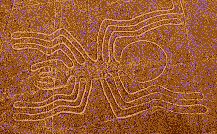
--- Nazca Lines ---
However, if we interpret the "Big Picture" in a macroscopic way, we might see the "spider" image as an artist's rendition of the Earth's geomagnetic lines (notice the Earth is in the "heart" [Thorax] position):
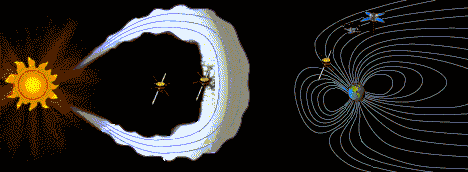
--- ISTP Sun-Earth Connections Event --- |
This image looks like a giant spider, or some other insect, unless one sees an aquatic life form.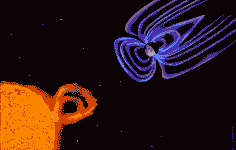 |
The "cosmic fingerprint" may become less or more identifiable if the image(s) of the Earth's magnetic field lines are shown in a full, or partially reversed mode of expression. Imagine if the "mirror image" impressions of our bilateral body were shown in an overlapped manner.
Perhaps we have been looking at the "Big Picture" of the Nazca Lines with a small minded perspective. Maybe we need to consider that the images are microcosmic portrayals of macrocosmic events, whether or not the original artist(s) were cognizant of their efforts as being expressions of such. Or, like the peoples of ancient cultures that memorized constellations of stars/planets by using a type of dot-to-dot game from which arose pictures of familiarity to them in their respective cultures, the artist(s) of the Nazca lines made "Big Pictures" to emphasize looking at the images from a holistic appreciation of circumstances that are "larger than life," just as are the geomagnetic lines "bigger than conventional life," which is symbolically replicated in a small way by the "bigger than life" images seen on motion picture theater screens, a thought mentioned earlier. (Note: those that did the actual work of making the lines may have been forced, "persuaded," or "encouraged" to do so and there was only one or a handful of people who actually had the image of such figures in their mind(s) that may have been created by drugs, poor nutrition, or some other means that distorted conventional perception to make the "artist(s)" more "receptive" to self-manipulation of their own interpretations of such perceptions brought about by varying states of physiological changes of an intermittent or prolonged duration of different intensities.)
Along with finger-prints, a view of finger patterns is helpful, such as citing the recurring usage of three fingers and one thumb (a 3 to one ratio) for cartoon characters, and the three-patterned spread of fingers used by Commander Spock of the old Star Trek television and Motion picture series of films, though we could add the hand displays of different gangs. No less, we could also mention the ensembles of cartoon and fairy tale characters which were in trios, such as Popeye-Olive-Brutus; Yogi bear, Boo-boo, the Ranger; Three bears (and Goldilocks); Three little pigs, Three billy goats gruff; Hansel-Gretal-Witch; Red Riding Hood-Grandma-Wolf; etc., despite variations which centered on one or two characters (or the anomalous "seven +1" in the story of snow white and the seven dwarfs, though we could make this a "9" by adding in the wicked step mother and woodsmen who was supposed to kill Snow White); thus providing us with yet another example of subject areas in which a limitation was applied.
 3-to-1 cartoon fingers Cartoon characters aren't real, but the symbolism they represent, is. |
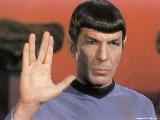 Five fingered pattern-of-3 |
Entertainment 3's page 1
In addition to the convention amongst those who study Children's Literature and are made aware of the recurring "three" pattern, we should also mention the usage of non-name names, such as "little red ride hood", "snow white", and "goldilocks" instead of "real" names such as Gretal, Rapunzel, or Mary (such as in "Mary had a little lamb"... even if her pet lamb was not dignified with a name as many children do with cats and dogs or other animals). This criteria is part of a psychology that is not looked at in detail, but would make for an interesting doctoral dissertation... so long as it evades the dispensation of analogy to present conventions of psychopathology that often lead into the realm of non-sensical psycho-babbled esoterica.
Outside the realm of cartoons and other television or/and motion picture we might want to include the present-day considered esoteric realm of fables and mythology, though in the past they may have garnered a well-respected reputation of being factual accounts, some of which have persisted into today and applied with updated information such as we now consider star gazing as Astronomy and Alchemy as Chemistry— but we can include the topic of Astrology and the concept of the "soul", devoid of its religious Communism (commonism), Eastern philosophical Socialism (communally relevant application), or "New Age" conventionalized democracies of preferential choice. Let us thus take an example of which I can speak personally of:
One pattern of behavior that some people are aware of is referred to as an "old soul", in that a young person exhibits characteristics we typically ascribe to someone who is chronologically older. Their interests, habits, tastes, expressed thoughts, etc., give others the impression they are in the presence of someone who has experiences that can only be acquired from having lived for many years. Personally, I know of at least one young girl like this; whose 3 siblings exhibit above average I.Q's. The young girl is more interested in being around adults who have knowledge beyond conventional day to day interests and doesn't really like to associate with kids her own age because she feels they are particularly devoid of the complexities and extensive information she is seeking, as determined by her level of curiosity, though she does not commonly express this with typical speech patterns, associations and conversational indulgences. While some of her expressions and interests do in fact exhibit that of an older adult, she does not yet have the vocabulary to express a full compliment of her adult-like perceptions that I have witnessed on several occasions. It's as if she were genetically endowed with the knowledge of one or more previous life times but can not access all the information she has. As a compensatory reaction there is an inclination to rely on the perception of subtleties that, to others can appear to be incongruous to their own reality of perceptions which are supported by others who also do not use their own abilities to focus on subtleties and instead rely on a crude democracy of generalized social acceptance guided by whomever is socially popular and can influence others to think as they do. School is difficult in the sense she becomes frequently bored due to "having heard the same information many times before", or "I already know this", or "everyone is so stupid" (because they do not share in her large list of memories that appear to have been transferred genetically to her like the transference of memory said to occur in some lab animals). She can often predict what a person is going to say or do... though she herself makes some errors in judgment... perhaps because she is preoccupied with trying to unravel... that is, make sense of the many indistinct impressions her mind is being confronted with. Such information comes to her in whispers, shadows, echoes... and the like, which she may fumbly spew forth in a cryptic manner— as interpreted by those who are not familiar with the problems sometime encountered by youthful "old souls" whose parents and grandparents may not be in-tune with the vagaries presented to those experiencing life as an old soul in a young body. Having a constrained old soul in a young body can make life difficult at times, especially if those in one's social/familial surroundings do not have the conscious of mind to appreciate the circumstances and can provide instructive support without attempting to engage in one or another exploitation. Indeed, we need an environment especially geared for the variations of "souls" in order that they may reach that which they can achieve on a personal level, and quite possibly share with the rest of humanity. But we must remember they are not normal in the conventional sense since they have a normalcy which can only be applied to those who are experiencing an active "soul"— be it young, old or ancient. If they live amongst or nearby to those who do not have some appreciable sensibility, or those who think they understand what an old soul means but actually don't, life can be frustrating and unfulfilling... or even seem worthless... because who and what they are have no currently active means of becoming a socially viable individual unless they allow themselves the necessary time with the necessary patience to develop their unique qualities with their own techniques of personal guidance, like a superego does when confronting an id and ego. However, the "old soul" topic should be contrasted with "young soul" and "ancient soul" counter-parts. A young-soul may become eventually become an old soul in a future generation, but not all young souls make the transition. Some older people exhibit a young soul and give the impression of being unable to grow up, while an "ancient soul" having arisen on the scene of someone's experiences may find that they have a feeling of being called for a journey away from the planet Earth... as if they are ready to transition beyond the confines of their present humanity... and thus think quite differently in how they compile information that most may correlate in standardized... and thus expected ways. Hence, another pattern of humanity is the young soul- old soul- ancient soul criteria that has no wide-spread acknowledgment, even amongst those who are particularly aware of the "old soul" idea and may relate to it in the fashion of the "Virgin- Mother- Crone" triad. However, both sets of three may themselves be labeling systems which portray an underlying circumstance that we are unable to accurately articulate because we as adults in this time period lack the experiences and vocabulary to give anything more concise... all the while overall human biology on this planet continues to deteriorate in concert with the deteriorations of the planet and planetary system. Yet, in speaking of the "soul" variations, we do not typically attempt to address the issue of trying to define what "soul" may mean outside the context of religion or some eastern philosophy. Nor do we engage in a philosophical sojourn directed at wondering whether a "soul" represents some sort of energy which all life forms may have in some manner, and whether inanimate forms can have a "soul" with respect to an energy, since atoms do. In fact, different life forms and "inanimate life" forms may have a soul characteristic of their respective reality... keeping in mind that such a consideration is a metaphysic that others may scoff at just as many of us when looking upon nature worship or the idea of animism (which is a belief that the wordweb dictionary describes as: "all natural objects and the universe itself have souls"). Thus, the reality of an insect may have its own respective types of soul variations, and that it is inappropriate for us to lump all souls into a singular definition because we are using a singular word to describe different variables we are trying to apply as a means of validating some personal sensibility that we favor and want to evaluate in a proportion to our attempts to substantiate the equation being used for our own ego. And as with other things (such as we find in the actions of businesses, various government entities, and religions), one may be dealing with a soul that is experiencing moments of stability, instability and high instability... even if one does not customarily assign the word "soul" to a social, much less commercial entity. |
if we look at the fossil record of dinosaurs for example, incomplete though it may be, we find the same recurring theme of limitation, despite the claims that "mixing the traits of different ethnic groups" increases the overall viability of the species by way of genetic diversity... when the entire stock of "genetic diversity" is an historical record of limitation as an environmentally induced rule for the purpose of maintaining some semblance of equilibrium for adaptation to a state of diminishing returns:
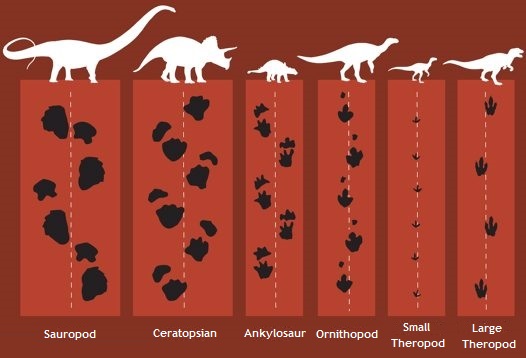
Comparing Dinosaur Footprints
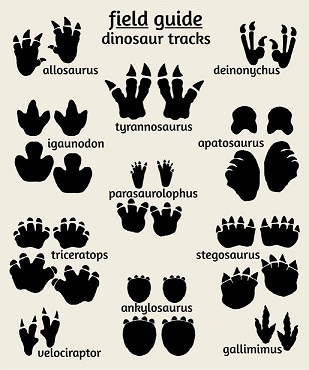
Various images
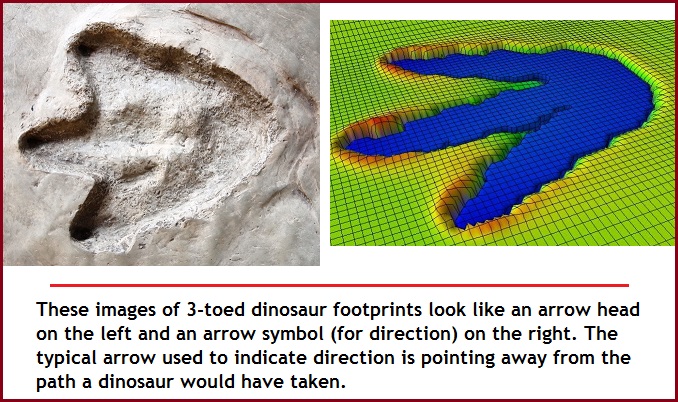
Secrets of Dinosaur footprints revealed

Fossil tracks in Australia
If we look at the quantity of two-pointed horns on the heads of animals, regardless if we make distinctions involving, bone, keratin, etc., we encounter the idea of a single-horned Unicorn and Narwhal, with many animals two horns as the most common (suggested as an expression of a bilateral body plan), with the occasion of three or four horns cropping up instead of two, and the instance where deer have multiple points on two antlers.
The same thing occurs in the design of fish tails:
Rounded : Eel, Clarias (Cat fish).
Truncate : Tillapia.
Emerginate : Almost all of spesies have it.
Double Emarginate : Barracuda
Forked : Almost all of spesies have it.
Lunate : Thunnus or Tuna.
Caudal Fin TYPE dividen as three:
- DIPICERCAL : There isn't split (Rounded, Truncate)
- HOMOCERCAL : Have symmetrical split (Emarginate, Forked, Lunate)
- HETEROCERCAL : Have asymmetrical split (on Shark)
Source: Blogspot: Icthyology
Page initially created: Friday, 19-August-2017... 3:35 AM
Initial Posting: Sunday, 13th-May-2018... 7:20 AM
Most Recent update: Friday, 17th, March 2023... 10:43 AM
Herb O. Buckland
herbobuckland@hotmail.com